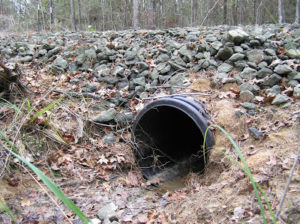Expert Road Construction Providers for Smooth Traveling
Expert Road Construction Providers for Smooth Traveling
Blog Article
Culvert Setup Made Easy: Step-by-Step Guide for Success
Installing culverts may look like an uncomplicated job, yet making sure a successful outcome requires mindful preparation and execution. From choosing the ideal culvert dimension to incorporating proper drainage actions, each action in the setup process plays a crucial duty in the performance and longevity of the culvert system. By adhering to a systematic method and taking note of crucial information, the installation can proceed efficiently, reducing prospective concerns down the line. Remain tuned to uncover the important steps and factors to consider that can make culvert setup a seamless and successful undertaking.
Picking the Right Culvert Size
Choosing the appropriate culvert size is critical for making sure efficient water flow and architectural honesty in culvert installment jobs - Pad Construction. The size of the culvert straight influences the circulation capacity of water with the framework. A culvert that is too little can bring about flooding and overflow, while one that is too big may result in lowered water speed, potentially creating debris build-up and blockages
To identify the appropriate culvert size, elements such as the watershed location, optimal flow rates, and hydraulic performance demand to be carefully considered. Computations based upon these specifications help in picking a size that can adequately handle the anticipated water volume while reducing the threat of clogs and structural failing.
It is vital to get in touch with design standards and requirements to make certain that the chosen culvert dimension satisfies the project requirements and neighborhood guidelines (Pad Construction). By choosing the right culvert size, task supervisors can maximize water flow, avoid possible concerns, and boost the total performance and long life of the culvert installment
Preparing the Installment Website
Reliable culvert setup requires thorough preparation of the installment website to make sure optimal structural assistance and functionality. Prior to commencing the setup process, it is crucial to get rid of the site of any particles, plants, or blockages that can impede the culvert's placement. Ensuring a degree foundation is essential for the correct positioning and stability of the culvert. This might include rating the site to develop a smooth, even surface area that can sufficiently support the weight of the culvert and any expected loads. Furthermore, proper compaction of the soil below the culvert is required to stop clearing up or moving over time.
Additionally, it is crucial to take into consideration elements such as dirt make-up, groundwater levels, and environmental effects when preparing the setup site. Carrying out a detailed website assessment can help identify any possible challenges or threats that may influence the culvert's performance. By taking the time to prepare the setup site correctly, you can help guarantee a successful culvert installation that meets architectural needs and makes certain lasting performance.
Placing the Culvert Properly

The grade at which the culvert is put is critical for keeping an appropriate slope for water flow. A steady slope helps stop merging and advertises efficient drainage. Furthermore, the culvert needs to be oriented correctly to make sure that the inlet and outlet are in the appropriate areas. This orientation is necessary for the culvert to operate effectively in handling water circulation.
Backfilling and Condensing the Soil
Appropriate backfilling and compaction of the soil around the culvert is vital to ensure stability and protect against potential issues in the future. Once the culvert is correctly put, the next crucial action is to backfill the area around it with appropriate product. The backfill product should be without rocks, particles, and raw material to stay clear of damages to the culvert. It is recommended to utilize granular product such as sand or gravel for backfilling, as it offers excellent water drainage and compaction residential or commercial properties.
After placing the backfill product, it is essential to portable it in layers of uniform thickness. Using a compactor or a mechanical meddle, small the dirt delicately to avoid harming the culvert. Compaction aids in reducing the possibilities of negotiation and guarantees uniform assistance around the culvert. It is essential to portable the dirt evenly Pad Construction on all sides of the culvert to maintain its architectural integrity.
Proper backfilling and compaction not only supply stability to the culvert however additionally assist in avoiding dirt disintegration and maintaining the durability of the culvert system.
Making Certain Proper Drainage Integration
Integrating reliable drain remedies plays a critical function in the overall performance and longevity of culvert setups. Correct drain combination is important for managing water circulation, stopping erosion, and making certain the architectural stability of the culvert system. To achieve this, it is vital to make a thorough drain strategy that thinks about elements such as the quantity of water anticipated, the topography of the area, and the kind of soil existing.

Furthermore, including attributes like disintegration control actions, such as riprap or vegetation, can further enhance the performance of the drainage system. By very carefully intending and executing these drainage remedies, culvert setups can function effectively and hold up against the test of time.
Final Thought
Finally, proper culvert setup is critical for maintaining effective water drainage systems. By picking the right culvert size, preparing the installment website, placing the culvert appropriately, backfilling and condensing the soil, and guaranteeing appropriate drain assimilation, success can be attained. Adhering to these actions will certainly help ensure the long life and performance of the culvert, inevitably contributing to the overall success of the drain system.
Report this page